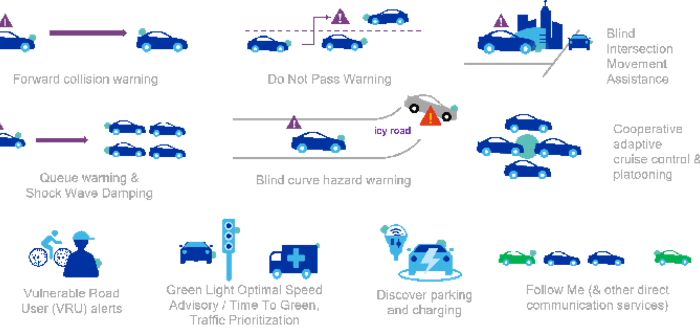A consortium comprising Audi, Ericsson, Swarco Traffic Systems, the University of Kaiserslautern, and Qualcomm Technologies, has completed the world’s first cross-border demonstration for Cellular Vehicle-to-Everything (C-V2X) direct communication.
The companies, which formed the Connected Vehicle to Everything of Tomorrow (ConVeX) consortium in 2016 to carry out the first announced C-V2X trial based upon the 3rd Generation Partnership Project’s (3GPP) Release 14, participated in cross-border digital testbed Project Day in Schengen, Luxembourg, at the new trilateral testbed hosted by France’s Ministry for the Ecological and Inclusive Transition, the German Federal Ministry of Transport and Digital Infrastructure (BMVI), the Luxembourg Ministry of Mobility & Public Works, and the Luxembourg Ministry of the Economy. ConVeX, co-funded by BMVI, showcased the reliability, range and performance of C-V2X direct communication between vehicles and with infrastructure, across the three trans-European borders.
Audi vehicles and Swarco’s intelligent road infrastructure are equipped with C-V2X technology using the Qualcomm 9150 chipset platform. Throughout the event, the Qualcomm 9150 C-V2X Platform was used to show vehicle-to-vehicle (V2V) and vehicle-to-infrastructure (V2I) safety use cases, demonstrating the maturity and potential of C-V2X technology and the ability to operate without the need for SIM subscription (via PC5) to potentially address challenges faced with roaming and network subscriptions. The use cases demonstrated included Roadworks Warnings (RWW), In-Vehicle Information (IVI) and Slow or Stationary Vehicle Warnings.
Swarco provides connected and cooperative traffic management on all established channels. In Schengen through the ConVeX project, Swarco provided for the first time C-V2X technology-based communications between real infrastructure components and vehicles on a public road in Europe. With connected and automated driving functions needing highly reliable, robust and low-latency communication, Swarco features C-V2X communication in its portfolio as the company believes C-V2X is a key technology for developing Cooperative Intelligent Transport Systems (C-ITS), with its evolution toward 5G. The cross-border demonstration follows the successful cooperation and integration of the consortium’s technology throughout 2018 and into 2019 around Europe, China, Japan, Korea, Australia and the USA.
“Since ConVeX was founded almost two years ago, we’ve been witness to some of the most pioneering advancements in bridging the language gap between road infrastructure and connected vehicles,” said Michael Schuch, COO and speaker of the executive board at Swarco AG. “By bringing together some of the most creative minds within the auto, telecommunications and infrastructure industries, we’ve been able to showcase a seamless and technical C-V2X experience that we will soon be able to bring to everyday road users.”
Jan-Peter Meyer-Kahlen, head of ICT development centers at Eurolab Aachen, commented, “This demonstration showcased the importance of global connectivity solutions with scalable, flexible, secure and future-proof solutions. We’re happy to have taken the next step with ConVeX and with the support of governments from France, Luxembourg and Germany. We’re hopeful that manufacturers and fleet operators across the world see this demonstration and understand that with the right partners, achieving the full potential of connected vehicles is ultimately possible.”
Prof. Hans Schotten, from Kaiserslautern University, added, “When the ConVeX consortium was established, we were focused on the enormous potential that connected and collaborative mobility had to improve traffic efficiency, enhance safety and lower emissions. Today we’ve witnessed exactly that.”





